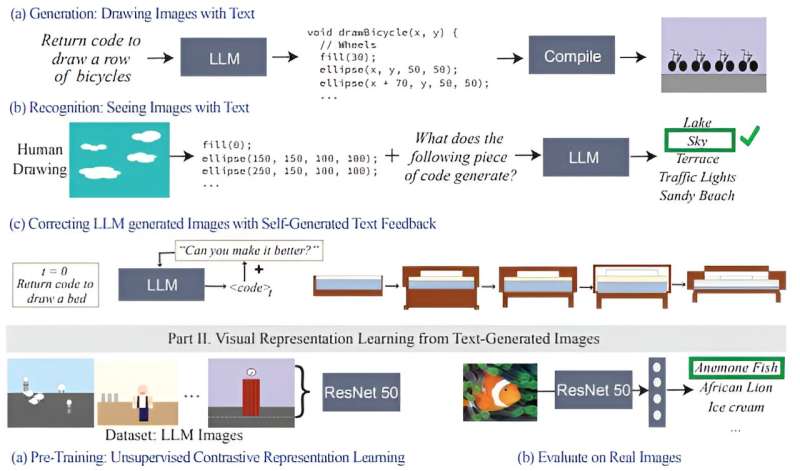
JUNE 17, 2024 by Alex Shipps
Collected at: https://techxplore.com/news/2024-06-image-free-vision-real-photos.html
You’ve likely heard that a picture is worth a thousand words, but can a large language model (LLM) get the picture if it’s never seen images before?
As it turns out, language models that are trained purely on text have a solid understanding of the visual world. They can write image-rendering code to generate complex scenes with intriguing objects and compositions—and even when that knowledge is not used properly, LLMs can refine their images. Researchers from MIT’s Computer Science and Artificial Intelligence Laboratory (CSAIL) observed this when prompting language models to self-correct their code for different images, where the systems improved on their simple clipart drawings with each query.
The visual knowledge of these language models is gained from how concepts like shapes and colors are described across the internet, whether in language or code. When given a direction like “draw a parrot in the jungle,” users jog the LLM to consider what it’s read in descriptions before.
To assess how much visual knowledge LLMs have, the CSAIL team constructed a “vision checkup” for LLMs: using their “Visual Aptitude Dataset,” they tested the models’ abilities to draw, recognize, and self-correct these concepts. Collecting each final draft of these illustrations, the researchers trained a computer vision system that identifies the content of real photos.
Their work is published on the arXiv preprint server.
“We essentially train a vision system without directly using any visual data,” says Tamar Rott Shaham, co-lead author of the study and an MIT electrical engineering and computer science (EECS) postdoc at CSAIL. “Our team queried language models to write image-rendering codes to generate data for us and then trained the vision system to evaluate natural images. We were inspired by the question of how visual concepts are represented through other mediums, like text. To express their visual knowledge, LLMs can use code as a common ground between text and vision.”
To build this dataset, the researchers first queried the models to generate code for different shapes, objects, and scenes. Then, they compiled that code to render simple digital illustrations, like a row of bicycles, showing that LLMs understand spatial relations well enough to draw the two-wheelers in a horizontal row. As another example, the model generated a car-shaped cake, combining two random concepts. The language model also produced a glowing light bulb, indicating its ability to create visual effects.
“Our work shows that when you query an LLM (without multimodal pre-training) to create an image, it knows much more than it seems,” says co-lead author, EECS Ph.D. student, and CSAIL member Pratyusha Sharma. “Let’s say you asked it to draw a chair. The model knows other things about this piece of furniture that it may not have immediately rendered, so users can query the model to improve the visual it produces with each iteration. Surprisingly, the model can iteratively enrich the drawing by improving the rendering code to a significant extent.”
The researchers gathered these illustrations, which were then used to train a computer vision system that can recognize objects within real photos (despite never having seen one before). With this synthetic, text-generated data as its only reference point, the system outperforms other procedurally generated image datasets that were trained with authentic photos.
The CSAIL team believes that combining the hidden visual knowledge of LLMs with the artistic capabilities of other AI tools like diffusion models could also be beneficial. Systems like Midjourney sometimes lack the know-how to consistently tweak the finer details in an image, making it difficult for them to handle requests like reducing how many cars are pictured, or placing an object behind another. If an LLM sketched out the requested change for the diffusion model beforehand, the resulting edit could be more satisfactory.
More information: Pratyusha Sharma et al, A Vision Check-up for Language Models, arXiv (2024). DOI: 10.48550/arxiv.2401.01862
Journal information: arXiv

Leave a Reply